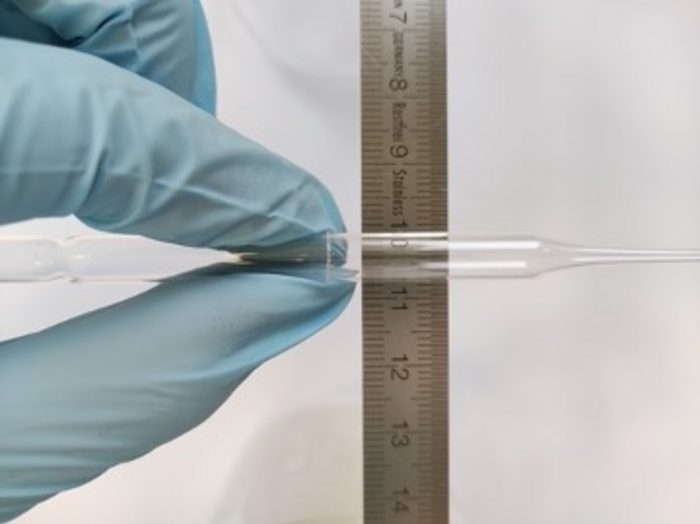Perovskites, with their extremely high efficiency in conveying electric charges from light, are claimed to be the next-generation material for LED displays and solar panels.

Single-crystal organometallic perovskite optical fiber. Image Credit: Dr. Lei Su.
A team of researchers guided by Dr. Lei Su at the Queen Mary University of London has developed a totally new application of perovskites as optical fibers.
Optical fibers are minute wires that are as thin as a strand of human hair, through which light moves at a superfast speed—100 times quicker than electrons in cables. These minute optical fibers convey most internet data.
Presently, the majority of optical fibers are composed of glass. The perovskite optical fiber designed by Dr. Su’s team contains just a single piece of perovskite crystal. The optical fibers possess a core width as low as 50 μm and are highly flexible—they are bendable to a radius of 3.5 mm.
In contrast to their polycrystal counterparts, single-crystal organometallic perovskites are more efficient, more stable, more durable, and have fewer flaws. Researchers have thus been aiming to create single-crystal perovskite optical fibers that can offer this high efficiency to fiber optics.
Single-crystal perovskite fibers could be integrated into current fiber-optical networks, to substitute key components in this system—for example in more efficient lasing and energy conversions, improving the speed and quality of our broadband networks.
Dr Lei Su, Reader, Photonics, Queen Mary University of London
Dr. Su and the team could grow and exactly control the diameter and length of single-crystal organometallic perovskite fibers in liquid solution (which is inexpensive to run) by employing a new temperature growth technique. They slowly altered the temperature, heating position, and line contact during the process to guarantee nonstop growth in the length while avoiding unplanned growth in the width.
With their technique, the length of the fiber could be regulated, and the cross-section of the perovskite fiber core could be diverse.
Corresponding to their predictions, because of the single-crystal quality, their fibers demonstrated to have good constancy spanning many months, and a minimum transmission loss—below 0.7 dB/cm adequate for creating optical devices.
They possess significant flexibility (bendable to a radius as small as 3.5 mm) and larger photocurrent values compared to those of a polycrystalline equivalent (the polycrystalline MAPbBr3 milliwire photodetector with comparable length).
This technology could also be used in medical imaging as high-resolution detectors. The small diameter of the fiber can be used to capture a much smaller pixel compared to the state of the art. So that means by using our fiber so we can have the pixel in micrometer scales, giving a much, much higher resolution image for doctors to make better and more accurate diagnosis.
Dr Lei Su, Reader, Photonics, Queen Mary University of London
“We could also use these fibers in textiles that absorb the light. Then when we're wearing for example clothes or a device with these kinds of fiber woven into the textile, they could convert the solar energy into electrical power. So we could have solar-powered clothing,” Dr Su added.
Journal Reference
Zhou, Y., et al. (2022) Single-crystal organometallic perovskite optical fibers. Science Advances. doi.org/10.1126/sciadv.abq8629.